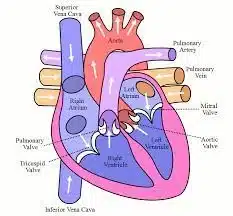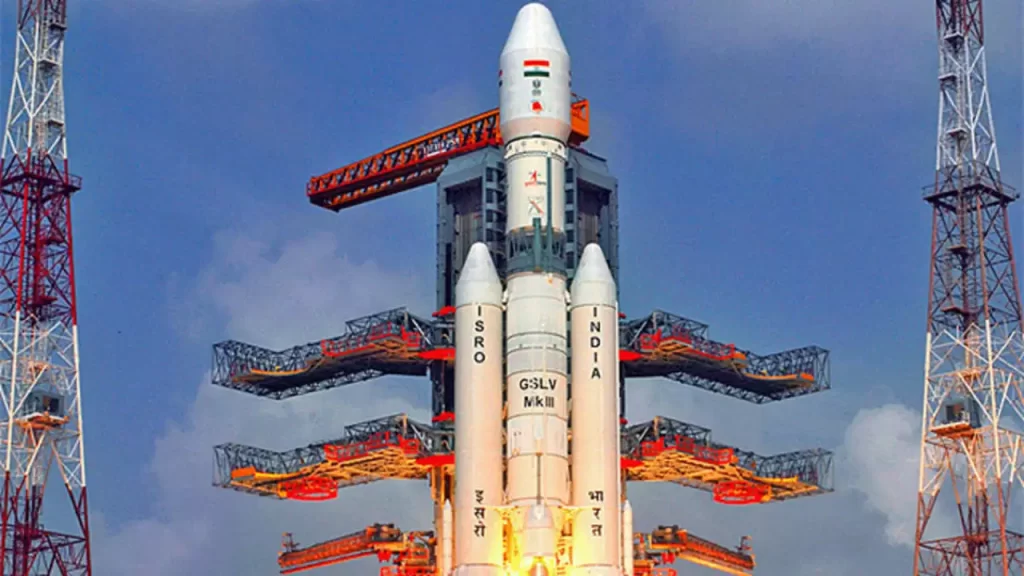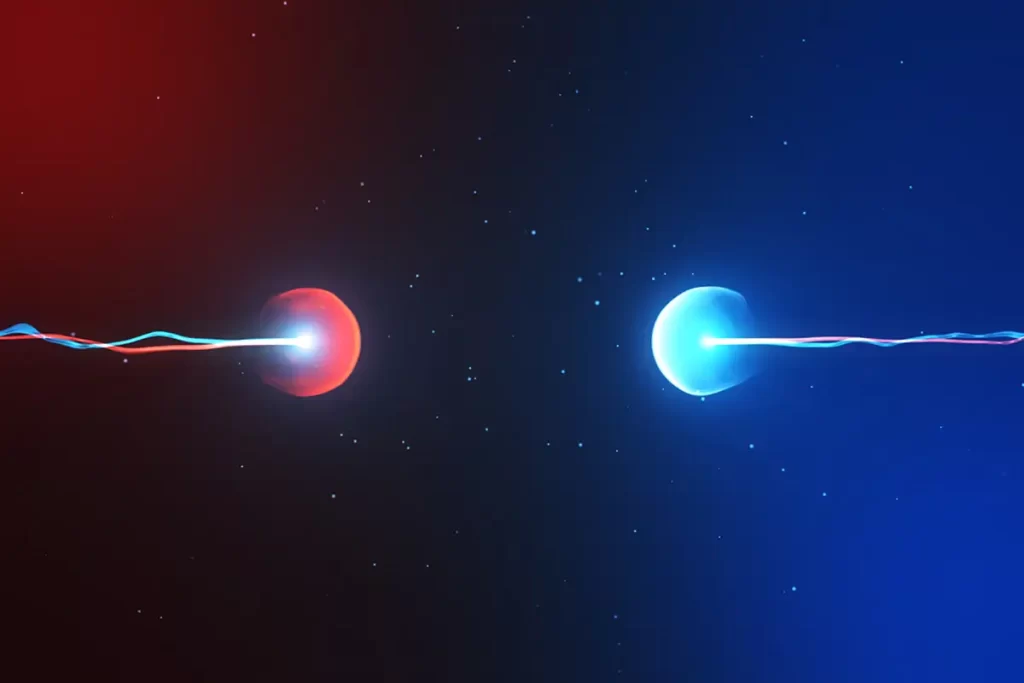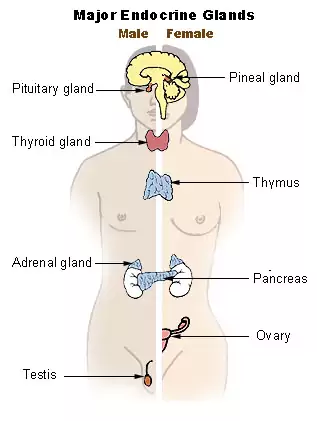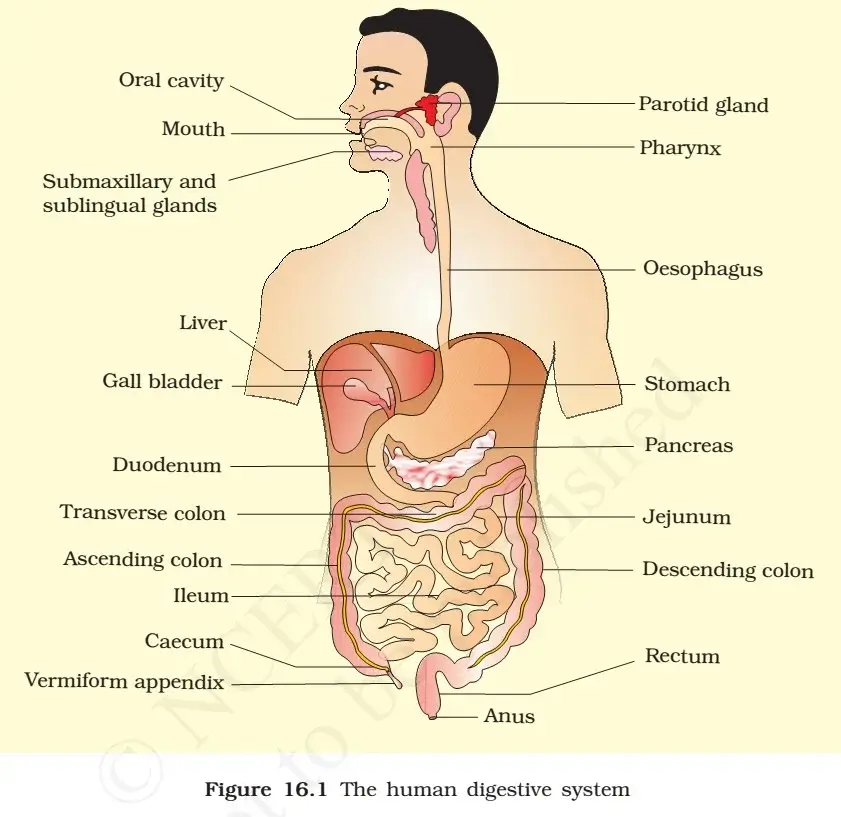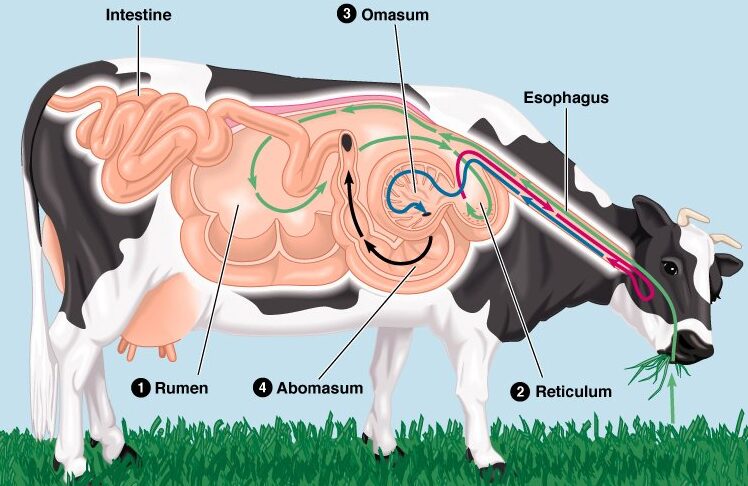Blood Circulation System
- A network of organs that allow the circulation of blood throughout the body is also known as the cardiovascular system or human circulatory system.
- The human circulatory system consists of a network of arteries, veins, and capillaries, with the heart pumping blood through it.
- The blood circulatory system (cardiovascular system) delivers nutrients and oxygen to all cells in the body.
- It consists of the heart and the blood vessels running through the entire body. The arteries carry blood away from the heart; the veins carry it back to the heart. The system of blood vessels resembles a tree: The “trunk” – the main artery (aorta) – branches into large arteries, which lead to smaller and smaller vessels. The smallest arteries end in a network of tiny vessels known as the capillary network.
Blood circulation system in human body is a closed network consisting of four major components:
- The heart
- Blood
- Blood vessels
- Lymph
These four, with the help of certain other organs such as the lungs, are responsible for the circulation of blood in the human body.
Major Components of the human circulatory system are mentioned below.
The Heart
- The heart is a muscular organ, located roughly at the body’s midline in the thoracic region, and responsible for the pumping of blood in the body.
- The heart is divided into four chambers: Right atrium, right ventricle, left atrium and left ventricles.
- The atriums collect the blood in the heart and the ventricles pump it to different organs.
Blood
- Blood is a fluid connective tissue which plays an essential role in the circulatory system.
- It carries oxygen and nutrients to all parts of the body.
- It also regulates the temperature and acidic balance of the body.
Blood Vessels
There are three types of blood vessels in the human body:
- Artilleries– They carry blood away from the heart. The arteries in the systemic loop carry oxygenated blood to different parts of the body while the ones in the pulmonary loop carry deoxygenated blood to the lungs.
- Veins– They carry deoxygenated blood from the body and oxygenated blood from the lungs into the heart.
- Capillaries– Arteries break down into a minuscule network of capillaries, which are the smallest blood vessels and present in the lungs and muscles.
Lymph
- The human circulatory system consists of another body fluid called lymph. It is also known as tissue fluid.
- Lymph is a colourless fluid consisting of salts, proteins, water, which transport and circulates digested food and absorbed fat to intercellular spaces in the tissues.
- Unlike the circulatory system, lymph is not pumped; instead, it passively flows through a network of vessels.
Features of Circulatory System
The crucial features of human circulatory are as follows:
- The human circulatory system consists of blood, heart, blood vessels, and lymph.
- The human circulatory system circulates blood through two loops (double circulation) – One for oxygenated blood, another for deoxygenated blood.
- The human heart consists of four chambers – two ventricles and two auricles.
- The human circulatory system possesses a body-wide network of blood vessels. These comprise arteries, veins, and capillaries.
- The primary function of blood vessels is to transport oxygenated blood and nutrients to all parts of the body. It is also tasked with collecting metabolic wastes to be expelled from the body.
- Most circulatory system diagrams do not visually represent is its sheer length. Theoretically, if the veins, arteries, and capillaries of a human were laid out, end to end, it would span a total distance of 1,00,000 kilometres (or roughly eight times the diameter of the Earth).
Functions of Circulatory System
The most important function of the circulatory system is transporting oxygen throughout the body. The other vital functions of the human circulatory system are as follows:
- It helps in sustaining all the organ systems.
- It transports blood, nutrients, oxygen, carbon dioxide and hormones throughout the body.
- It protects cells from pathogens.
- It acts as an interface for cell-to-cell interaction.
- The substances present in the blood helps repair the damaged tissue.
Types of blood circulation
- There isn’t only one blood circulatory system in the human body, but two, which are connected: The systemic circulation provides organs, tissues and cells with blood so that they get oxygen and other vital substances. The pulmonary circulation is where the fresh oxygen we breathe in enters the blood. At the same time, carbon dioxide is released from the blood.
- The blood circulates through the heart twice; hence, it is called double circulation. Other animals like fish have single circulation, where blood completes a circuit through the entire animal only once.
- The main advantage of double circulation is that every tissue in the body has a steady supply of oxygenated blood, and it does not get mixed with the deoxygenated blood.
- The systemic circulation:
It carries oxygenated blood from the heart to all parts of the body through a complex system of arteries and capillaries. It also carries deoxygenated blood from these organs back to the heart through veins.
- The pulmonary circulation:
After the heart receives the deoxygenated blood from different parts of the body, it pumps those to the lungs for expelling the carbon dioxide and other impurities and collect oxygen, after which the oxygenated blood is sent back to the heart for systemic circulation.
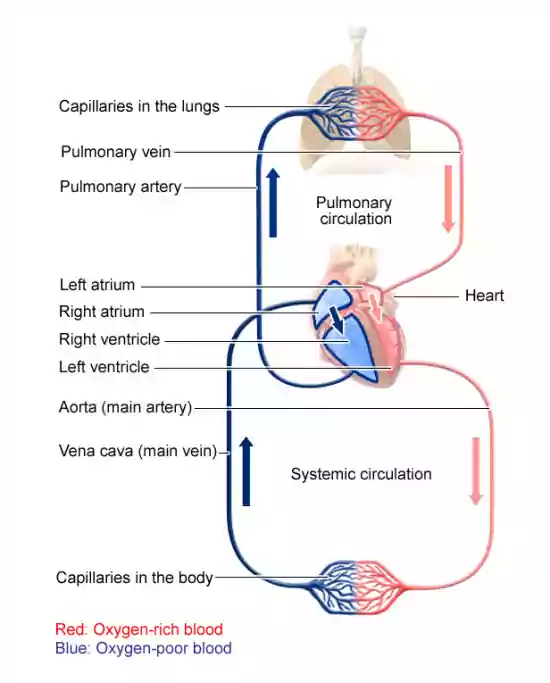
Process of Blood Circulation
- Blood circulation starts when the heart relaxes between two heartbeats: The blood flows from both atria (the upper two chambers of the heart) into the ventricles (the lower two chambers), which then expand. The following phase is called the ejection period, which is when both ventricles pump the blood into the large arteries.
- In the systemic circulation, the left ventricle pumps oxygen-rich blood into the main artery (aorta). The blood travels from the main artery to larger and smaller arteries and into the capillary network. There the blood drops off oxygen, nutrients and other important substances and picks up carbon dioxide and waste products. The blood, which is now low in oxygen, is collected in veins and travels to the right atrium and into the right ventricle.
- This is where pulmonary circulation begins: The right ventricle pumps low-oxygen blood into the pulmonary artery, which branches off into smaller and smaller arteries and capillaries. The capillaries form a fine network around the pulmonary vesicles (grape-like air sacs at the end of the airways). This is where carbon dioxide is released from the blood into the air inside the pulmonary vesicles, and fresh oxygen enters the bloodstream. When we breathe out, carbon dioxide leaves our body. Oxygen-rich blood travels through the pulmonary veins and the left atrium into the left ventricle. The next heartbeat starts a new cycle of systemic circulation.
Important Facts on Blood Circulation System
- The English physician, William Harvey (A.D.1578–1657), discovered the circulation of blood.
- The circulatory patterns are of two types – open or closed.
- Open circulatory system is present in arthropods and molluscs in which blood pumped by the heart passes through large vessels into open spaces or body cavities called sinuses.
- Annelids and chordates have a closed circulatory system in which the blood pumped by the heart is always circulated through a closed network of blood vessels. This pattern is considered to be more advantageous as the flow of fluid can be more precisely regulated.
- All vertebrates possess a muscular chambered heart. Fishes have a 2-chambered heart with an atrium and a ventricle. Amphibians and the reptiles (except crocodiles) have a 3-chambered heart with two atria and a single ventricle, whereas crocodiles, birds and mammals possess a 4-chambered heart with two atria and two ventricles.
- In fishes the heart pumps out deoxygenated blood which is oxygenated by the gills and supplied to the body parts from where deoxygenated blood is returned to the heart (single circulation).
- In amphibians and reptiles, the left atrium receives oxygenated blood from the gills/lungs/skin and the right atrium gets the deoxygenated blood from other body parts. However, they get mixed up in the single ventricle which pumps out mixed blood (incomplete double circulation).
- In birds and mammals, oxygenated and deoxygenated blood received by the left and right atria respectively passes on to the ventricles of the same sides. The ventricles pump it out without any mixing up, i.e., two separate circulatory pathways are present in these organisms, hence, these animals have double circulation. Let us study the human circulatory system.
- Does sponges and hydra also have blood? Animals such as sponges and Hydra do not possess any circulatory system. The water in which they live brings food and oxygen as it enters their bodies. The water carries away waste materials and carbon dioxide as it moves out. Thus, these animals do not need a circulatory fluid like the blood.
Disorders of Circulatory System
High Blood Pressure (Hypertension)
- Hypertension is the term for blood pressure that is higher than normal (120/80).
- In this measurement 120 mm Hg (millimetres of mercury pressure) is the systolic, or pumping, pressure and 80 mm Hg is the diastolic, or resting, pressure.
- If repeated checks of blood pressure of an individual is 140/90 (140 over 90) or higher, it shows hypertension.
- High blood pressure leads to heart diseases and also affects vital organs like brain and kidney.
Coronary Artery Disease (CAD)
- Coronary Artery Disease, often referred to as atherosclerosis, affects the vessels that supply blood to the heart muscle. It is caused by deposits of calcium, fat, cholesterol and fibrous tissues, which makes the lumen of arteries narrower.
Angina
- It is also called ‘angina pectoris’. A symptom of acute chest pain appears when no enough oxygen is reaching the heart muscle.
- Angina can occur in men and women of any age but it is more common among the middle-aged and elderly. It occurs due to conditions that affect the blood flow.
Heart Failure
- Heart failure means the state of heart when it is not pumping blood effectively enough to meet the needs of the body. It is sometimes called congestive heart failure because congestion of the lungs is one of the main symptoms of this disease.
- Heart failure is not the same as cardiac arrest (when the heart stops beating) or a heart attack (when the heart muscle is suddenly damaged by an inadequate blood supply).
Also refer:
- Human Digestive System
- Genome Editing And CRISPR-Cas9 Technology
- Top 50 Science MCQs For Competitive Exams
- Top 50 Science Questions From Previous Year UPSC Prelims
- Top 25 MCQs on Virus
- Previous Years Questions Of UPSC On Human Diseases

